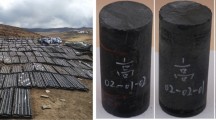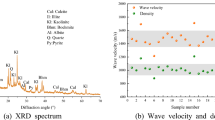Abstract
In order to study the influence of confining pressure and water content on the mechanical properties, fracture evolution and energy damage mechanism of deep-buried carbonaceous slate, uniaxial and triaxial compression tests were carried out under natural and saturated states and acoustic emission monitored. The deep-buried carbonaceous slate samples were obtained at a depth of 1020 m from the Lanjiayan tunnel in Sichuan province, China, where the maximum in situ stress has been measured at 44.2 MPa. The results suggest that water has a significant softening effect on the strength and deformation characteristics of carbonaceous slate, but the effect decreases with an increase in the confining pressure. When both the confining pressure and water content are increased, the acoustic emission events and dissipated energy gradually increase at the pre-peak and post-peak stages. Thus, the AE evolution type seen in the natural state under low confining pressure usually presents as a main shock-type event, and it changes to a foreshock–main shock–after shock event when saturated and at high confining pressures. Based on the S-shaped energy evolution law, the damage evolution process of carbonaceous slate was analyzed. The damage stress thresholds σ ea and σ eb were obtained, which can be considered as the thresholds of the rock entering the energy-hardening and energy-softening stages. Finally, a new brittleness energy index BDE is proposed to describe the influence of confining pressure and water content on the damage mechanism of deep-buried carbonaceous slate.



















Similar content being viewed by others
References
Aubertin M, Gill DE, Simon R (1994) On the use of the brittleness index modified (BIM) to estimate the post-peak behavior of rocks. Aqua Fennica 23:24–25
Bennett KC, Berla LA, Nix WD, Borja RI (2015) Instrumented nanoindentation and 3D mechanistic modeling of a shale at multiple scales. Acta Geotech 10(1):1–14
Cai M, Kaiser PK, Tasaka Y, Maejima T, Morioka H, Minami M (2004) Generalized crack initiation and crack damage stress thresholds of brittle rock masses near underground excavations. Int J Rock Mech Min Sci 41(5):833–847
Chen L, Liu JF, Wang CP, Liu J, Su R, Wang J (2014) Characterization of damage evolution in granite under compressive stress condition and its effect on permeability. Int J Rock Mech Min Sci 71(287–290):340–349
Deng Y, Chen M, Jin Y, Zou DW (2016) Theoretical analysis and experimental research on the energy dissipation of rock crushing based on fractal theory. J Nat Gas Sci Eng 33:231–239
Duan K, Kwok CY, Ma X (2016) DEM simulations of sandstone under true triaxial compressive tests. Acta Geotech 12:495–510
Eberhardt E, Stead D, Stimpson B, Read R (1998) Identifying crack initiation and propagation thresholds in brittle rock. Can Geotech J 35(2):222–233
Erguler ZA, Ulusay R (2009) Water-induced variations in mechanical properties of clay-bearing rocks. Int J Rock Mech Min Sci 46(46):355–370
Feng XT, Chen SL, Zhou H (2004) Real-time computerized tomography (CT) experiments on sandstone damage evolution during triaxial compression with chemical corrosion. Int J Rock Mech Min Sci 41(2):181–192
Fortin J, Stanchits S, Dresen G, Gueguen Y (2009) Acoustic emissions monitoring during inelastic deformation of porous sandstone: comparison of three modes of deformation. Pure Appl Geophys 166(5):823–841
Guo JQ, Liu XL, Qiao CS (2014) Experimental study of mechanical properties and energy mechanism of karst limestone under natural and saturated states. Chin J Rock Mech Eng 33(2):296–308
Hua AZ, You MQ (2001) Rock failure due to energy release during unloading and application to underground rock burst control. Tunn Undergr Sp Tech 16(3):241–246
Khazaei C, Hazzard J, Chalaturnyk R (2015) Damage quantification of intact rocks using acoustic emission energies recorded during uniaxial compression test and discrete element modeling. Comput Geotech 67:94–102
Kim JS, Lee KS, Cho WJ, Choi HJ, Cho GC (2015) A comparative evaluation of stress–strain and acoustic emission methods for quantitative damage assessments of brittle rock. Rock Mech Rock Eng 48(2):495–508
Li HR, Yang CH, Liu YG, Chen F, Ma HL, Wang BW (2014) Experimental research on ultrasonic velocity and acoustic emission properties of granite under failure process. Chin J Geotech Eng 36(10):1915–1923
Ma CC, Li TB, Xing HL, Zhang H, Wang MJ, Liu TY, Chen GQ, Chen ZQ (2016) Brittle rock modeling approach and its validation using excavation-induced micro-seismicity. Rock Mech Rock Eng 49(8):1–14
Martin CD, Chandler NA (1994) The progressive fracture of Lac du Bonnet granite. Int J Rock Mech Min Sci 31(6):643–659
Martin CD (1993) The strength of massive Lac du Bonnet granite around underground openings. Ph.D. thesis, University of Manitoba
Meng LB, Li TB, Jiang Y, Wang R, Li YR (2013) Characteristics and mechanisms of large deformation in the Zhegu mountain tunnel on the Sichuan-Tibet highway. Tunn Undergr Sp Tech 37(6):157–164
Mohamadi M, Wan RG (2016) Strength and post-peak response of Colorado shale at high pressure and temperature. Int J Rock Mech Min Sci 84:34–46
Nakao A, Nara Y, Kubo T (2016) P-wave propagation in dry rocks under controlled temperature and humidity. Int J Rock Mech Min Sci 86:157–165
Nara Y, Hiroyoshi N, Yoneda T, Kaneko K (2010) Effects of relative humidity and temperature on subcritical crack growth in igneous rock. Int J Rock Mech Min Sci 47(4):640–646
Nara Y, Morimoto K, Yoneda T, Hiroyoshi N, Kaneko K (2011) Effects of humidity and temperature on subcritical crack growth in sandstone. Int J Solids Struct 48(7–8):1130–1140
Peng RD, Ju Y, Gao F, Xie HP (2014) Energy analysis on damage of coal under cyclical triaxial loading and unloading conditions. Chin J Coal Sci Eng 39(2):245–252
Pestman BJ, Munster JGV (1996) An acoustic emission study of damage development and stress-memory effects in sandstone. Int J Rock Mech Min Sci 33(6):585–593
Schreyer H, Sulsky D (2016) Constitutive and numerical framework for modeling joints and faults in rock. Int J Num Analyt Meth Geomech 40(9):1253–1283
Semnani SJ, White JA, Borja RI (2016) Thermoplasticity and strain localization in transversely isotropic materials based on anisotropic critical state plasticity. Int J Num Analyt Meth Geomech 40(18):2423–2449
Tjioe M, Borja RI (2015) On the pore-scale mechanisms leading to brittle and ductile deformation behavior of crystalline rocks. Int J Num Analyt Meth Geomech 39(11):1165–1187
Tjioe M, Borja RI (2016) Pore-scale modeling of deformation and shear band bifurcation in porous crystalline rocks. Int J Numer Meth Engng 108(3):183–212
Wang SR, Liu ZW, Qu XH, Fang JB (2009) Large deformation mechanics mechanism and rigid-gap-flexible-layer supporting technology of soft rock tunnel. Chin J Highway Trans 22(6):90–95
Xie HP, Ju Y, Li LY, Peng RD (2008) Energy mechanism of deformation and failure of rock masses. Chin J Rock Mech Eng 27(9):1729–1739
Xie HP, Liu JF, Ju Y, Li J, Xie LZ (2011) Fractal property of spatial distribution of acoustic emissions during the failure process of bedded rock salt. Int J Rock Mech Min Sci 48(8):1344–1351
Xie HP, Peng RD, Ju Y (2004) Energy dissipation of rock deformation and fracture. Chin J Rock Mech Eng 23(21):3565–3570
Xiong DG, Zhao ZM, Su CD, Wang GY (2011) Experimental study of effect of water-saturated state on mechanical properties of rock on coal measure strata. Chin J Rock Mech Eng 30(5):998–1006
Yang SQ, Jing HW, Wang SY (2012) Experimental investigation on the strength, deformability, failure behavior and acoustic emission locations of red sandstone under triaxial compression. Rock Mech Rock Eng 45(4):583–606
Yang T, Xu T, Liu H, Zhang CM, Wang SY, Rui YQ, Shen L (2014) Rheological characteristics of weak rock mass and effects on the long-term stability of slopes. Rock Mech Rock Eng 47(6):2253–2263
Yu HC, Zhao Y, Liu HD (2015) Experimental study of influence of water on stress relaxation of rock under triaxial stresses. Chin J Rock Mech Eng 34(2):313–322
Zhou H, Meng FZ, Zhang CQ, Rongchao XU, Jingjing LU (2014) Quantitative evaluation of rock brittleness based on stress-strain curve. Chin J Rock Mech Eng 33(6):1114–1122
Zhang K, Cao P, Ma G, Wang WH, Fan WC, Li KH (2016) Strength, fragmentation and fractal properties of mixed flaws. Acta Geotech 11(4):901–912
Acknowledgements
This research was financially supported by the National Key R&D Program of China (Nos. 2016YFC0802201 and 2016YFC0802210) and Doctoral Innovation Fund Program of Southwest Jiaotong University.
Author information
Authors and Affiliations
Corresponding author
Ethics declarations
Conflict of interest
The authors declare that we have no conflict of interest.
Rights and permissions
About this article
Cite this article
Chen, Z., He, C., Wu, D. et al. Fracture evolution and energy mechanism of deep-buried carbonaceous slate. Acta Geotech. 12, 1243–1260 (2017). https://doi.org/10.1007/s11440-017-0606-5
Received:
Accepted:
Published:
Issue Date:
DOI: https://doi.org/10.1007/s11440-017-0606-5




